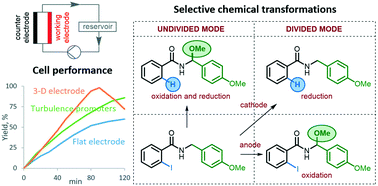A design of flow electrolysis cell for ‘Home’ fabrication†
Abstract
Despite extensive literature on organic electrosynthesis, it has never become a routine procedure in organic synthesis laboratories. One reason is certainly a lack of attention to the design of the cell used for the electrolysis; an appropriate cell is the dominant factor in determining the rate of conversion and the final conversion. Beaker cells predominate in published laboratory electrosyntheses but their use can limit reaction performance, and ease of scale-up, particularly where high rates of conversion are required without compromising selectivity for the desired product. This paper describes a simple design of a flow cell for operation in a recycle mode that is straightforward to fabricate and its performance is illustrated with anodic and cathodic electrosyntheses. The advantages of using turbulence promoters in the flow channel and a three dimensional electrode (reticulated vitreous carbon) are demonstrated. The cell allows the preparation of up to 5 mmol per hour of isolated product, and 20 mmol of product can be obtained over 4 h with high conversion of starting material. The cell design is readily scalable to enable the synthesis of larger quantities of product, and provides the capability to introduce a separator for organic electrosynthesis in a divided mode.



 Please wait while we load your content...
Please wait while we load your content...